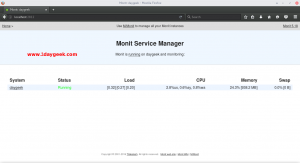

We have outlined how to use two of our preferred options below- Monit and Datadog. It can be easily integrated with incumbent monitoring systems. More home server specific Monit examples to follow, so keep checking back.There are lots of standard tools available to monitor a TorQ stack. As you can see Monit allows for automatic server monitoring, which can be a big help for system administrators. That is it for Webmin monitoring with Monit. You should see Webmin process status as shown in the picture below. (if you have domain name pointing to your server).Now, fire up your web browser and visit one of the following URLs depending on how your Monit is configured (be sure to use the correct port number): The whole sequence of commands for testing and reloading Monit is shown in the picture below. If Monit is not running, then start it using sudo monit command instead.

If Monit is running, reload Monit configurations using the following command: sudo /etc/init.d/monit reload Then, check to see if Monit is already running using the following command: sudo /etc/init.d/monit status You should see the following message: Control File Syntax OK. Once you make any changes you have to test Monit configuration: sudo monit -t You can customize the above rules as you please. If 2 restarts occur within 3 monitoring cycles, Monit will stop monitoring Webmin process status instead of bombarding you with email alerts. Monit Alerts - Process Not Found And Auto RestartĪ cycle is 1 monitoring period as set in /etc/monit/monitrc. As example, the picture below shows 2 emails from monit: one when CouchPotato process was found to be not running and another after Monit successfully restarted CouchPotato.
Monit system monitoring code#
This code will make Monit send you an email alert when Webmin is not running. If you are using Webmin behind SSL (HTTPS access) then use TCPSSL instead of TCP in the above code block. If 2 restarts within 3 cycles then unmonitor If failed host 127.0.0.1 port 10000 type TCP for 2 cycles then restart Start program = "/etc/init.d/webmin start" To monitor Webmin with Monit, create a Monit configuration file using the following command: sudo /etc/monit/conf.d/webminĬopy the following contents to it, save, and exit (press Ctrl X, press Y, and press ENTER). In this guide, we are going to assume you are using port 10000, which is the Webmin default port. If you followed our Webmin installation guide then you can open settings file using the following command: nano /etc/webmin/nf Webmin Access Details On Atomic ToolkitĪlternatively, you can open Webmin settings file and look for the port. If you installed Webmin using AtoMiC ToolKit then you can use the "Access Details" feature from within AtoMiC ToolKit Webmin submenu. In case, you do not know your port number there are couple of ways to find it. If you find this guide interesting, you probably already know your port. Find Webmin Portįirst, you will need to find what port your Webmin setup is listening on. Monit configurations for various services are loaded from /etc/monit/conf.d folder. Just another layer of automation for your home server.īefore enabling Web admin monitoring, it is required that you have a working Monit instance with a proper /etc/monit/monitrc file.
Monit system monitoring download#
In this guide, I will show you how to monitor Webmin process status so that the automatic download system you setup keeps running as it should. Monitor web server status (Apache, NGINX, and MySQL).Monitor file server status (Samba and NFS).Monitor Hard drive SMART health and temperature.Processor or CPU temperature monitoring.Server hard drive storage monitoring (HDD space).Home server system load monitoring (CPU, RAM, Swap).I use Monit to monitor several services listed below: Monitor your home server with Monit: On my recently built energy-efficient home server, I test and run several apps including Webmin. Setup Monit Web Admin Monitoring Script.


 0 kommentar(er)
0 kommentar(er)
